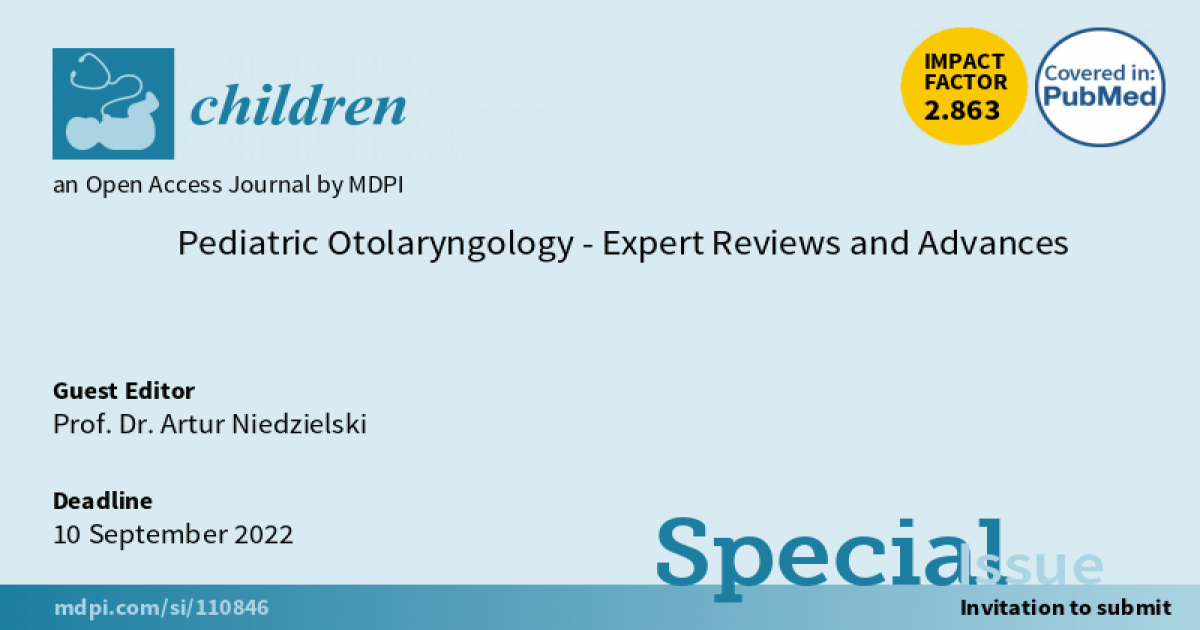- 2.1Impact Factor
- 3.8CiteScore
- 16 daysTime to First Decision
Pediatric Otolaryngology-Expert Reviews and Advances
This special issue belongs to the section “Global Pediatric Health“.
Special Issue Information
Dear Colleagues,
The field of pediatric otolaryngology is under constant development. Our aim is to provide the latest clinical knowledge and scientific research, allowing us to excel in our professional growth and expand clinical application.
This Special Issue wishes to highlight the current state of research on the most common ENT disorders in children. Topics of interest include—but are not limited to—adenoid hypertrophy/adenoiditis, rhinosinusitis (acute and chronic), otitis media with effusion, acute otitis media, obstructive sleep apnea, hearing loss, deafness, and speech disorders.
Experts in the field are invited to submit manuscripts on all related topics. Original research papers, case reports, literature reviews, and systematic reviews are welcome.
I look forward to receiving your contributions to this Special Issue, which will provide valuable insight into all aspects of current trends in pediatric otolaryngology.
Prof. Dr. Artur Niedzielski
Guest Editor
Manuscript Submission Information
Manuscripts should be submitted online at www.mdpi.com by registering and logging in to this website. Once you are registered, click here to go to the submission form. Manuscripts can be submitted until the deadline. All submissions that pass pre-check are peer-reviewed. Accepted papers will be published continuously in the journal (as soon as accepted) and will be listed together on the special issue website. Research articles, review articles as well as short communications are invited. For planned papers, a title and short abstract (about 250 words) can be sent to the Editorial Office for assessment.
Submitted manuscripts should not have been published previously, nor be under consideration for publication elsewhere (except conference proceedings papers). All manuscripts are thoroughly refereed through a single-blind peer-review process. A guide for authors and other relevant information for submission of manuscripts is available on the Instructions for Authors page. Children is an international peer-reviewed open access monthly journal published by MDPI.
Please visit the Instructions for Authors page before submitting a manuscript. The Article Processing Charge (APC) for publication in this open access journal is 2400 CHF (Swiss Francs). Submitted papers should be well formatted and use good English. Authors may use MDPI's English editing service prior to publication or during author revisions.
Keywords
- adenoid hypertrophy
- otitis media with effusion
- acute otitis media
- hearing loss
- chronic rhinosinusitis
- acute rhinosinusitis
- obstructive sleep apnea
- speech disorders
- quality of life

Benefits of Publishing in a Special Issue
- Ease of navigation: Grouping papers by topic helps scholars navigate broad scope journals more efficiently.
- Greater discoverability: Special Issues support the reach and impact of scientific research. Articles in Special Issues are more discoverable and cited more frequently.
- Expansion of research network: Special Issues facilitate connections among authors, fostering scientific collaborations.
- External promotion: Articles in Special Issues are often promoted through the journal's social media, increasing their visibility.
- e-Book format: Special Issues with more than 10 articles can be published as dedicated e-books, ensuring wide and rapid dissemination.

